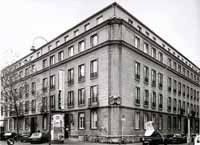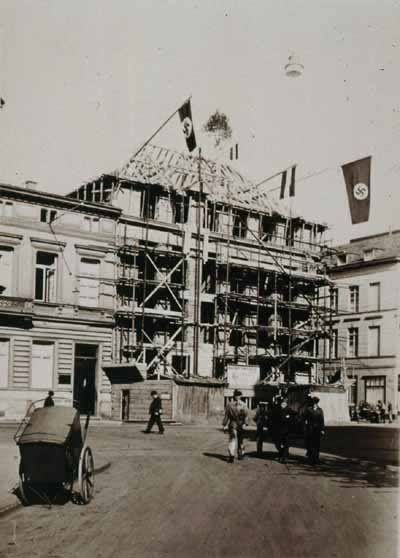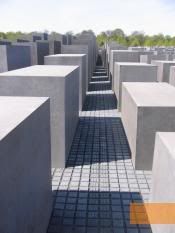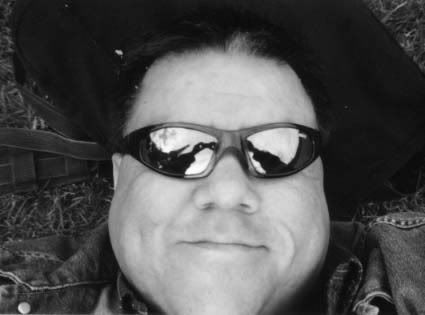21st century Nazi Sites in Germany
by Jim Marquez
“He who closes his eyes to the past, closes his eyes to the present. He who suppresses the memory of man’s inhumanity to man, is himself in danger of one day becoming inhuman.”
--Richard von Weizacker
1985
Mayhem ensued for myself and my buddy as we trekked across Germany for World Cup 2006 this past summer; gracious and kind hosts the Germans were. This being my fourth world cup experience, I especially looked forward to not only the matches and football fan festivities shared by the 4 million international guests, but, also to the darker, more historical aspects that Germany openly sheds light upon.
Two such places exist for our benefit: the “Documentation Centre on National Socialism” in Cologne along the Rhine River, and the newly christened “Memorial to the Murdered Jews in Europe” in the middle of Deutschland’s capital of Berlin. Both are staggering glimpses into the madness that once was.

“The EL-DE House”, Cologne:
On an unremarkable middle-class neighborhood corner, just down the street from a pedestrian-only zone of shops and cafes frequented more by the locals than the tourists sits the “EL-DE House”. The old headquarters of the secret police, or “Gestapo”, from 1935-1945. And that’s usually the case, isn’t it? Where horror dwells, on any given, drab anonymous street just around the corner from the local bread shop.
At the end of Germany’s involvement in the war, April 1945, Cologne, targeted for its strategically placed rail system and close proximity to the French and Dutch borders, was wiped off the face of the map by Allied bombers. Two structures withstood the hell from above: the city’s 1,000 year old cathedral, and, ironically, western Germany’s Gestapo HQ: “The EL-DE House”, so named after the initials of the building’s architect Leopold Dahmen.
Imagine the odds. And, after 5o years of collecting dust, it wasn’t until 1997 that the building was put into full use for one sole purpose, the same as with all the memorials in the new Germany: so people won’t forget…
Entering the building, bright lights, antiseptic in the air, cold despite the insufferable heat of the summer, the only thing that stands out in the oversized lobby is an old man sitting at a bare desk, smiling, asking for a modest donation. He hands you a brochure and directs you to start your tour down a stairwell. After, he says, you can take your time upstairs in the archives room.
In contrast to the lobby you enter a dark, musty, corridor with flickering lights, yellow streaked walls, and squeaking doors. Low ceilings add to the claustrophobic vibe. You immediately feel something is not right. It’s the same itch I got when I entered Dachau some years ago. And, Terezin outside of Prague.
Nothing is pretty down here. The basement has retained the old horrors. The coffin-like cells remain. Those used to squire away the political prisoners before the war broke out, then, used to torture, brainwash, rape, and persuade others to serve the Fatherland. The air is heavy, hopelessness settles over your shoulders. There is no escape, other than at the end of the hallway and out back where the small courtyard sits with a tiny patch of grass that was used for the executions.
Most disturbing are the scratches of words, sentences, drawings, etched up and down the pitted and poorly plastered walls of the cells. Whittling away time before your next beating. Or worse. Thankfully the rooms are closed off by Plexiglas; you see the entire cell, catch a glimpse of the confines, shiver, then move on. The air gets harder to process. You must leave.
Shaking off the effects from below is no mean feat, but they quickly abide when you take the stairs back up into the light and continue to the archives: an airy, spacious but oddly sickly-tinged series of rooms. Again, that uneasiness returns but there are at least windows open to breathe in fresh air. And, haphazardly displayed about this top floor of the building are the meticulous records that were kept to document a regime thought to last a millennia.
War photos, government sanctioned newspapers, typed orders, propaganda cartoons, portraits of various officers, and films are placed somewhat in chronological fashion, but most are scattered on the walls, the floors, in book cases, on tables, matted within hanging glass partitions; not the tidiest of museums, the viewer is left to wander on his own, to gather information at a leisurely pace. There are no headsets to fumble with, nobody waving you on with a folded umbrella leading the tour, no peering security guards, no coat check-in. As unobtrusive a museum experience I have ever had.

Though this may turn off those used to a more traditional gallery excursion, you will certainly be rewarded by what you find near the end of your visit: a movie theatre.
Actually, a darkened room. With benches. And a screen. Push a button on the console below the screen and any of the dozens of pre-programmed movies they have pop up. Black & White. Silent. Pristine quality. Hitler riding into Cologne in an open air-car, the camera riding over his shoulder as he blesses the adoring crowds. Snippets of film showing a tracking shot riding alongside Hitler as he waves to the children in particular. Another angle of his hand up in his famed salute, but the camera has caught the setting sun from behind and it looks as if he is holding the sun in his right palm.
Films of the Nazis marching into Cologne by the Cathedral, out of the train station, and young girls swooning over them. Rallies with hundreds of thousands, at night, raising torches and chanting Hitler’s name. Hitler smoothing out his hair and mustache before going to the podium. Stuff you never saw in high school history class that’s for damn sure. The propaganda machine working overtime. Fascinating. Like watching a car wreck. You absolutely want and should look away, but you’ll find yourself, mouth agape, pushing the replay buttons over and over and over again...
“Memorial to the Murdered Jews of Europe”, Berlin:
Taking a few hours off from the World Cup was a must, for beyond the Brandenburg Gate was the nightly two-mile long fan fest and match viewing party. But just off the bustling Unter Den Linden metro stop, at the famed Adlon Hotel where heads of state spend the night, and past the British Embassy with its numerous armed-to-the-teeth-guards, sits the newest and most staggering of Holocaust memorials.
Opened in May 2005 and designed by American architect Peter Eisenmen (topside) & Berliner Dagmar von Wicklen (below ground) at the cost of Euro 28 million, this memorial is ironically and sweetly situated above the war time offices of Propaganda Minister Joseph Goebbels and a mere 300 meters from the Fuherbunker itself.
The memorial is simply a large parcel of land with 2,711 concrete slabs of various lengths and widths, placed head-to-head, side-to-side, row by row, short and tall, perfect rectangles, box-like shapes with no discernible names, writings, or dates; a grey and ominous labyrinth meant as a not too subtle glimpse at what it might be like if lost at a cemetery in purgatory.

You are left alone to wander the mazes, but be careful, the ground underfoot is undulating, so you are constantly veering left to right, up and over mole hills, at eyesight to the slabs one second and the next finding yourself standing nearly 5 feet below and traversing a canyon of these 2001- Space-Odyssey-type monoliths. Quiet as a morgue on a Sunday afternoon too. And since there is nothing but dull gray and cold concrete that flashes across your field of vision, you are left to your own thoughts, disquieting, and, no doubt an unnerving proposition to many. What are these things supposed to be? Caskets? People? And why are there only 2,700 of them? There were more victims than that.
You feel dizzy upon emerging. But, you are not done.
After a time to reflect, head down to the “Information Centre”, easily one of the most comprehensive and beautifully realized of such establishments.
Divided into five distinct rooms, the visitor is continually reminded of what is above because the same motif and color scheme is integrated into every square inch of the place. Dark hues, rectangular rooms, and the shapes of the slabs are embedded into the ceilings as if to show they are one and the same.
The “Introduction Room” is a long hallway with the history of the Third Reich and their insidious plans done up in photos, text, audio recordings and presented in large, clear, easy to follow text in multiple languages. The information is a bit much to take in all at once, but well worth the perusal. You are then led into another darker, chillier, and muted “Room of Dimensions”.
Personal accounts of their eradication in the forms of letters, postcards, diary pages, and scraps of paper are enlarged and encased in frosted, dimly lit displays embedded into the floor. You have to walk around these parcels of illumination and look down, just like visiting a loved one’s grave site.
Here is one postcard that was found on a dirt road in eastern Poland written by a 12 year old girl:
31 July 1942
Dear Father,
I am saying goodbye to you before I die. We would so love to live but they won’t let us. I am so scared of this death because the small children are being thrown alive into the pit.
Goodbye forever. I kiss you tenderly.
Yours, J
(Judith Wischnjatskaja)
The next “Room of Families” is just that. Fifteen families, young to old, are traced, followed before, during and after their persecution via family photo albums, government records, and letters in an intriguing attempt to personalize the tragedy even more for the visitor.
The “Room of Names” is an innocuous moniker, but it is the most haunting of the whole lot. The cavernous room is dim, cold; benches that look like tombs are spread out and about. Jumbo screens adorn the walls on all fours sides. It feels like you’re in a lonely train station in the middle of the night. A distant voice, then, intones the names of the dead. Their photos, worn & tattered & black & white, most smiling, flash on the screens along with their names and places of birth and eventual places of death.
It is calculated that it will take 6 years, 7 months, and 27 days to read all the names of these dead. Over six million. On a constant loop. Sometimes it is a female’s voice, or young man’s but the effect is chilling either way. You sit; lower your head, listen, an eternal roll call. A man can only take so much.
The next two, the “Room of Sites” and “Holocaust Memorials”, offer the visitor interactive screens, computers, audio, maps, all designed to show where these atrocities took place; their addresses, facts, figures, camp photos, death march routes, deportation centers, mass graves.
Nobody is left wanting for information.
These are but two of the many sites in Germany that house the knowledge to help us understand, reason, and learn. Never forget. Never again.
For more visit:





0 Comments:
Post a Comment
Subscribe to Post Comments [Atom]
<< Home